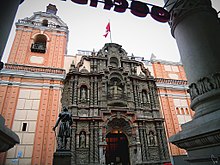Churrigueresque
Churrigueresque (/ˌtʃʊərɪɡəˈrɛsk/; Spanish: Churrigueresco), also but less commonly "Ultra Baroque", refers to a Spanish Baroque style of elaborate sculptural architectural ornament which emerged as a manner of stucco decoration in Spain in the late 17th century and was used until about 1750, marked by extreme, expressive and florid decorative detailing, normally found above the entrance on the main façade of a building.
Integrating sculpture and architecture even more radically, Narciso Tomé achieved striking chiaroscuro effects in his Transparente for the Toledo Cathedral.
Perhaps the most visually intoxicating form of the style was Mexican Churrigueresque, practiced in the mid-18th century by Lorenzo Rodriguez, whose masterpiece is the Sagrario Metropolitano (1749–69) in Mexico City, New Spain.
The altarpiece of the church of San Francisco Javier (National Museum of Viceroyalty) in Tepotzotlán, State of Mexico is also considered, along with its façade, one of the most important baroque churrigueresque works created by the Jesuits in New Spain.
Goodhue and Winslow developed the style after studying Churrigueresque and Plateresque ornamentation in Spanish Colonial buildings in Mexico.



